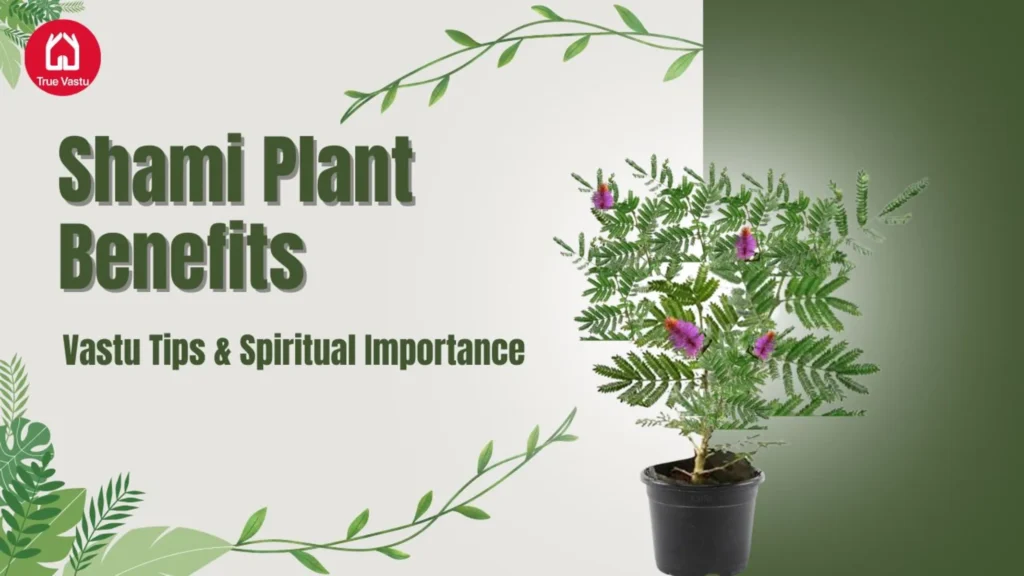Many plants bring positive results when planted at home. The Shami plant Benefits is one of those that holds a sacred connection to Lord Shiva and Lord Shani in Hindu belief. From a Vastu perspective as well, this plant is considered highly auspicious. If you follow certain guidelines related to it, you can be freed from many problems.
Cultural and Religious Significance
- The Shami plant is very important in Indian culture and religion.
- In the festival of Dussehra, people worship the Shami tree.
- It protected the Pandavas’ weapons during their time in exile in the Mahabharata.
- People believe the tree brings good luck and victory.
Shami Plant Benefits in Vastu Shastra
Here are the top benefits of keeping this plant at home.
| Benefit | Description |
| Divine Blessings | Brings blessings from Lord Shiva and Shani Dev |
| Planetary Healing | Helps reduce negative effects of planets and brings peace. |
| Shani Sade Sati Support | Gives strength and protection during the Shani Sade Sati phase. |
| Marriage Harmony | Removes delays in marriage and improves relationships. |
Divine Blessings: If you plant a Shami tree at home and worship it regularly, you will get Lord Shiva and Shani Dev”s blessings.
Planetary Healing: As per astrology, you can remove negative planetary effects and brings peace by placing this plant at home.
Support During Shani Sade Sati: Planting this tree at home during the difficult astrological phase of Shani Sade Sati offers many benefits.
Removes Marriage Obstacles: The tree also help you to remove marriage delays and improve your relationships.
How Shami Plant Looks
- Outer Structure
- Its size is medium tree that grows nearly 10–15 meters tall.
- Its trunk is rough that has brown or grey color.
- The plant has many branches that flare wide.
- Its Other Parts
- Its leaves are small which has green-grey color. They grow in pairs.
- Its has yellowish or greenish flowers that bloom in spring.
- Fruits are pods, like peas that are consumed by animals as food.
- Growth & Lifespan
- It is a strong and tough tree.
- It is slow to rise, but built to last.
- It can stay in very dry weather.
- It doesn’t require much water.
How to Place Shami Plant As Per Vastu?
- Vastu says the plant should not be kept indoors.
- Set it up in the balcony or on the rooftop.
- The best shami plant vastu direction is South direction.
- Plant it on a Saturday (Shani Dev’s Day) for maximum benefits.
- Avoid keeping it in direct sunlight.
Shami Plant Vastu
| Aspect | Summary |
| Vastu Significance | Auspicious in Vastu; helps those with Shani influence in horoscope. |
| Ideal Direction | Best: South; Alternatives: East or Northeast; or right side near exit. |
| Best Time to Plant | Saturday; especially during Shani Sade Sati or Dhaiya. |
| Rituals & Practices | Light mustard oil lamp on Saturdays; offer leaves on Shivling for peace. |
| Spiritual Importance | Represents Shani Mahadev; brings positive energy when placed correctly. |
| Vastu Expert Advice | Expert guidance ensures prosperity, protection, and harmony. |
Vastu Significance
- Shami plant is sacred in Vastu Shastra.
- Good for people with Shani influence in their horoscope.
Ideal Direction for Planting
- Best direction: South
- If south is not possible, use East or Northeast.
- In homes with no sunlight, place it on the right side when exiting the house. Learn More about :South-Facing Home Vastu
Best Time to Plant
- Saturday is the best day to plant this tree.
- Planting during Shani Sade Sati or Dhaiya periods gives more benefits.
Rituals and Practices
- Light a mustard oil lamp near the Shami plant every Saturday.
- It helps to reduce Saturn’s negative effects and bring peace.
- Offer Shami leaves on a Shivling to reduce life’s troubles.
- It also increases income and removes financial problems.
Spiritual Importance
- The Shami tree represents Shani Dev as per hindu belief.
- Proper placement enhances positive energy in the home.
Vastu Expert Advice
- Follow a Vastu expert’s guidance for best results.
- Right placement and timing can bring prosperity, protection, and harmony.
Use Shami Patra in Shiva Worship for Great Benefits
- It is the divine leave in hinduism.
- It is best for offering Lord Shiva, Lord Ganesh, and Shani Dev.
- You get blessings, protection, and wealth from these gods.
- It is often used during festivals such as Sawan, Navratri, and Dussehra.
- Worship Shivlinga on Sawan Mondays with proper rituals with this leave.
- It helps to cure diseases and improve health.
- You can reduce negative effects of Shani planet.
- It holds strong spiritual and religious value.
How to Grow Shami Plant at Home Step by Step?
-Choose High-Quality Seeds
- Get Shami seeds from a trusted nursery or garden shop.
- The seeds should be fresh and healthy.
-Pre-Soak the Seeds “
- Place the seeds in clean water and leave them for 12 to 24 hours.
- It makes the seed coat softer, helping the seed sprout faster.
-Gently Prepare (Scarify) the Seeds
- Softly scuff or rub the seed’s outer layer with the help of sandpaper or a knife.
- Be cautious not to damage the inner part of the seed to for healthy and quick germination.
-Sow the Seeds in Soil
- Fill a pot with well-draining soil or potting mix.
- Lightly mist the soil with water.
- Put the seeds in the soil and cover lightly. Water gently.
-Create the Right Conditions for Germination
- Keep the pot where it gets bright but indirect sunlight.
- Maintain consistent moisture, but don’t overwater.
With these simple steps, you can successfully grow this splendid and divine Shami plant at home.

How to Take Care of This Plant?
Just growing is not enough, you must take care of this regularly-
-Light Needs and Placement
- Requires bright, indirect sunlight for germination.
- Keep in a partially shaded area.
- Avoid direct, harsh sunlight in the early stages.
-Ideal Temperature Conditions
- Best germination temperature: 9°C to 20°C.
- Mature plants are sturdier.
- In hot regions (e.g., Rajasthan, Gujarat), keep in shade during peak summer.
-How to Prune the Plant
- Needs minimal pruning.
- Extract dry leaves or sagged flowers regularly.
- Pruning promotes new, healthy growth.
-Proper Watering Practices
- Keep soil consistently moist during germination.
- Avoid overwatering, just enough moisture is key.
- Mature plants require less water.
- Water only when the topsoil is dry.
- Can endure dry conditions well.
-Best Soil Mix & Fertilizer Use
- Use well-draining soil (loam + compost + sand).
- Fertilize lightly in spring and summer.
- Employ balanced fertilizer sparingly.
- Don’t over-fertilize.
-Detecting and Managing Pests
- Always check for aphids, mites, or scale insects.
- Use organic or chemical sprays if required.
- Keep plant area clean and well-maintained.
-Supporting and Shaping the Plant
- Employ stakes to support young or tall stems.
- Bind gently to guide shape and direction.
- Keeps the plant neat and strong.
These simple things will help to keep the plant healthy, strong, and beautiful whether indoors or outdoors.
Why Shami Plant Is Popular in Hinduism?
-Role in Hindu Rituals and Festivals
- During Dussehra, people exchange Shami leaves to bring goodness.
- The plant also brings blessings and prosperity at home.
-Historical References
- In the epic Mahabharata, Arjuna hid his weapons in a Shami tree during war.
- Later, he conquered a battle after praying to the tree. So, it became a symbol of strength and victory.
-Symbolism in Indian Culture
- It represents hope, strength, and survival.
- It teaches us to grow even in tough situations, just like it grows in deserts.
The Shami tree is more than just a plant. It stands for strength, courage, and tradition. In many stories and festivals, it is seen as a symbol of protection and survival. People believe it brings good luck and helps during tough times. It grows well in dry, desert areas of India.
FAQ
Is Shami good for home?
Yes, the Shami plant is considered auspicious and brings positive energy to the home.
Which god is linked to Shami?
Shami is associated with Lord Shiva, Lord Ganesh, and Shani Dev.
What are Shami plant benefits?
It brings peace, removes negative energies, and helps reduce the effects of bad planets.
Can we eat Shami leaves?
Yes, in traditional medicine, Shami leaves are used for their healing properties.
Why do we worship Shami?
We worship Shami to seek blessings, protection, and relief from planetary troubles.
